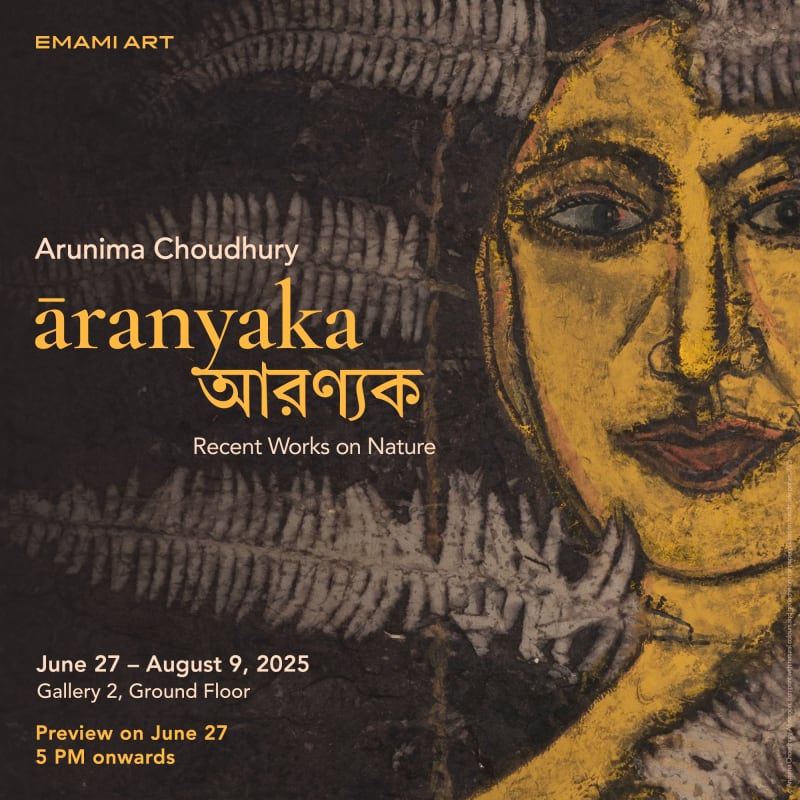My eyes desire green
My body desires a green garden
Bring the trees and plant them here
Let me look at them
- Shakti Chattopadhyay, Let Me Look at Them (tr. Arunava Sinha)
Arunima Choudhury’s (b. 1950) recent works in the exhibition evince a deep familiarity with the natural world, which appears both as a theme and a medium and also as a position informed by the long and troubled history of environmental change. For an avid gardener who spent her childhood in the lush green hill towns of North Bengal, her love for nature comes innately. However, although nature has long been a recurring presence in her work, she does not view it through a romantic lens by simply celebrating its unblemished beauty. Much like her favourite poets – Shakti Chattopadhyay, Jibanananda Das, and Binay Majumdar – she locates nature at the heart of our modern urban experiences, suggesting schisms and interconnectedness between humans and the natural environment, as well as a symbiosis between life, desire, and death.
Working across mediums, from eco-printing to hand embroidery, and in various formats such as long hanging scrolls and paintings, Arunima Choudhury prefers to call herself a storyteller. She utilises her work to tell stories, which encompass both personal thoughts and memories and widely familiar narratives, such as the decay of ecological sensibilities, the unquiet woods, and the rapid growth and expansion of techno-economic modernity, which results in the unprecedented destruction of natural habitats – including rivers, forests, and mountains – and the indigenous people who live there. Choudhury always takes sides with the victims, evoking a primal sympathy that builds a more profound kinship, holding us together. Having said so, in spirit, Choudhury is no environmental activist, and her paintings are by no means protest messages. They are profound in meaning, like poetry, in which form and content are inextricably intertwined.
We have said that nature holds centre stage in her entire oeuvre. However, it has increasingly gained intensity and complexity over the last two decades. In 2006, Choudhury made a deliberate decision to prepare colours derived from organic sources to use in her paintings, choosing them over industrially produced paints sold in tubes. This resolution led to extensive experimentation with natural colours, exploring the various possibilities of creating a compelling painting style. She had to start almost from scratch, travelling to places and collaborating with experts in textiles to learn methods that best suited her style and cause. It shows her profound sense of medium specificity, echoing the spirit of Nandalal Bose. Her tiny notebook of methods and materials reminds us of Nandalal’s Shilpa Charcha.
“I go where I can find leaves,” says Choudhury in one of her conversations with us. A keen explorer, she is busy experimenting with the new medium of eco-printing – a technique specific to natural textiles – to create paintings on rice paper. She is drawn to this method of directly transmitting the shapes of leaves or flowers onto the pictorial surface because it allows her to engage more closely with nature in her work as a trace of memory rather than a visual representation. In her ‘eco-prints’ in this show, the impressions of both ferns and roses convey a sense of aesthetic-botanical territoriality, encompassing weeds symbolising resilience, renewal, and endurance, as well as flowering plants that require special human care to grow. Leaves overwhelm Choudhury’s work; the synthesis of eco-printed leaf patterns, fluid brushstrokes, and patches gives her paintings a unique visual charm, rhythm, and organic feel – pointing to a new direction in her decades-long practice with natural colours.
The core theme of the show, the forest, embodying intense nature, exists both within and outside us, in the tropical Amazon as well as in the deeper terrains of the mind, emotions, and desires. In this exhibition, the forest belongs to a woman, more specifically, an ageing woman. Having navigated through mid-life crises and the disintegration of womanhood, she now finds renewed wholeness in nature’s deep sensuality, much like Rosalie in Thomas Mann’s novella, The Black Swan.
- Arkaprava Bose
Biography of the Artist
Born in 1950 In Siliguri, West Bengal, Arunima Choudhury holds a Diploma in Fine Arts from Indian College of Arts & Draftsmanship, Kolkata, 1974, and a Certificate in Graphic Design & Mass Communication from Chitrabani, Kolkata, 1978. Working primarily with natural colours on handmade papers, she is known for her works depicting the languid world of nature and human being, their intimacy and coexistence.
Her solo shows include The Dark Edge of Green curated by Nancy Adajania, Emami Art, Kolkata, 2022; Khela, Seagull Foundation of the Arts, Kolkata, 2007; and Nature as I See, Emami Art, Kolkata, 2020. She has participated in several important group exhibitions including Freedom & Awakening: Phases I & II, Kolkata Centre for Creativity in collaboration with Alipore Museum, Kolkata, 2023; Unconnected Yet, Bengal Boston Bridge, Academy of Fine Arts, Kolkata, 2023; Garden of Infinite Desires, Emami Art, Kolkata, 2023; Kolkata: Run in the Alley curated by Praneet Soi and Manuel Klappe, Marres, Netherlands, 2022; Feminine Facets, Emami Art, Kolkata, 2021; Constellations, Emami Art, Kolkata, 2021; and Seven Women Artists, Birla Academy of Art & Culture, Kolkata, 1996. among others.
Arunima Choudhury was awarded the Shilpi Maha Samman by West Bengal Rajya Charukala Parshad in 2022. One of her paintings Looking Back (2023) is part of the Kiran Nadar Museum of Art collection in New Delhi. She lives and works in Kolkata.

